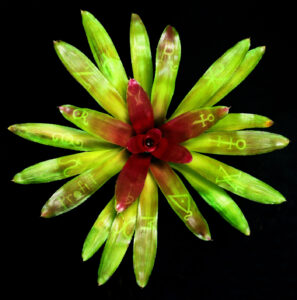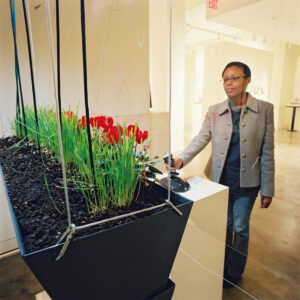
Knowledge of plants, key to creative intentions
By Lloyd Godman
From the art of photography to photosynthesis and a sustainable means of integrating plants into architecture.
In 1985, I set up and then ran the photography section at the Dunedin School of Art, in New Zealand, for 20 years. During this time my art practice moved from using a camera to a series of projects utilising camera-less images.
Concurrently, I had an interest in growing plants. In 1996, the two interests fused and I began using bromeliad plants to grow rudimentary images into the living tissue of the leaf. I would mask off areas of the leaf with opaque tape and as the plant grew, the leaf area deprived of light produced a change in pigment, which later revealed an image. The word “photograph” makes no reference to cameras and means “drawing with light”. Exploring the idea further, I concluded that the largest abstract photograph we know of is the planet Earth. As light from the sun speeds past the planet, plants capture and use the energy to grow. Plants are the ceaseless art makers, they are constantly “drawing with light”. Sequences from satellites reveal the changing nature of plants on the planet during the seasons, and over longer periods of time.

By 1999, my art with plants moved into interactive installations of suspended bromeliads including Tillandsia species. One installation, enLIGHTen included seven projected colour lights (red, green, blue) individually triggered as the audience moved through the space, that produced overlapping shadow patterns of the plants on large tissue paper screens. If the audience stopped moving, the projectors gradually turned off and the space fell into darkness. A key element of the work was to emphasise the importance of light to plants and the unique environment that is our planet. Somehow these plants could endure months in a gallery situation with no watering system and it intrigued me.
I began to study the biology of the various genera and discovered they are highly resilient. Many take all water and nutrients in via trichome cells on the leaf, so they do not need a constant supply of water at the roots. Like succulents, cacti and some other plants, they use a CAM cycle to grow, so the stomata remain closed during the day which allows them to conserve water. These factors enabled me to successfully utilise them in the various art installations.
In 2005, I was part of an exhibition at the Museum of Contemporary Art of Georgia in Atlanta. My work was a complex installation where the audience photographed themselves in front of faster-growing plants than the bromeliads. I used flowering cyclamens and wheat grass. The images taken by the audience were saved in a data base which was continually projected as a time lapse sequence of 50 images, selected from the first image shot to the very last. The concept was that during the exhibition the plants would appear to grow faster and faster via the time lapse. However, I was not present for the duration of the exhibition and over the three months of the install the plants died. My optimism and inexperience with these specific plants in this situation was too great. Interestingly, the image sequences taken by the audience, revealed that when the plants were alive, the demeanour of the audience was upbeat and happy, but when the plants failed and perished, their disposition became one of concern and worry.

As Dan Austin details in his article Hort Journal Australia Dec 2021-Jan 2022, there is too often a catastrophic disconnect between landscape designers’ concepts and the necessary knowledge to succeed with their selected plants.
In my experience, it is similar with artists working with plants in art galleries and installation situations. While the intentions are often admirable, the execution can fall short, with the plants eventually perishing. I remember an attempt to grow plants upside down in a gallery where the light levels were poor. Not unexpectedly, the plants failed to grow, turning from healthy plants to tortured twisted specimens that exemplified neglect within weeks.
I endorse Dan’s suggestion for designers to study horticulture, and it also applies to artists who wish to work with plants. I have a series of photographs that document the viability of various wall and roof gardens. I have witnessed maintenance budgets for some wall gardens spiral from two to five times the anticipated cost. From my early work with tillandsias in 1996, I continued to study the biology and growing methods of these plants. In 2015, I instigated a project, Tillandsia SWARM, experimenting with how tillandsias can be integrated into architecture in a sustainable manner. Part of this project has seen Tillandsia installed on the top of Melbourne’s Eureka Tower at level 92 for over seven years with no watering or nutrient system.
